As the amount of enterprise data centers increases, application systems scale out, and network environments grow complex, traditional backup solutions cannot adapt itself to these changes no matter which method it uses: Backing up data centers or application systems separately will complicate management and increase costs; backing up data centers or applications centrally will require high bandwidth, address demanding RTO/RPO requirements, and open extra firewalls. This will impose adverse impact on solution flexibility and security. Therefore, how to reduce costs while delivering powerful data management and protection capabilities poses the following challenges to a backup solution.
Challenge 1: Extraordinary Data Growth
- As informatization develops, data grows at extraordinary rates.
- Business-critical data is extremely important to any enterprises and therefore, must be fully protected.
Challenge 2: Unsatisfactory Backup and Recovery Speed
- Exponential data growth causes the original backup window unable to fulfill backup requirements.
- The prolonged recovery duration impairs service continuity.
Challenge 3: Harsh IT Environment
- Extra storage devices and management tools are required.
- IT investments keep shrinking under the pressure of budget cut and peer competition.
- IT personnel are required to work on effective approaches to the problems brought by quick data growth under limited budgets.
HUAWEI backup solutions can help implement disk/VTL-based unified data backup and recovery on UNIX, Window, Linux, and NetWare.
Except from providing global data protection solutions for common applications such as remote office backup, data center backup, file system backup and virtualization backup, Huawei delivers dedicated data protection solutions for specific applications to meet different industries' backup requirements. Huawei backup solution panorama is shown below:

Huawei can provide four application-based solutions: the file system backup solution, email backup solution, database backup solution, and virtualization backup solution, as shown below:

Project Background
- A provincial public security bureau generates up to 12.1 TB of data amount in its data center. A high-speed railway group generates 10 TB of data amount in its data center.
- The legacy backup system consists of IBM 3584 and ADIC i2000 physical tape libraries.
- The backup window cannot meet application requirements and the recovery process is insecure.
- Production data was backed up but no measures were taken for disaster recovery.
Requirements and Challenges
- High availability and zero single points of failure
- Consolidating the legacy network where more than 20 mid-range computers and microcomputers, 16 Oracle databases, one SQL Server database, and one VMware virtual machine have been deployed
- 8-hour backup window
- Mutual backup of two database centers
Solutions
- Deploy one dual-node VTL6000 in both local and remote data centers and enables deduplication.
- Configure 66 TB of storage in the provincial security bureau’s data center and 54 TB of storage in the high-speed railway group's data center.
Backs up service data to the local VTL6000 and remotely replicates data after they are deduplicated to achieve remote disaster recovery
Benefits
Shortened Backup Windows and Minimized Impact on Services
- The backup window is shortened from 16 hours to 8 hours with up to 700 MB/s of backup performance supported by the VTL6000.
Reduced Investment into Storage Devices and Network Bandwidth
- The leading deduplication technology contributes to a deduplication rate of 20:1 at least and saves 95% of storage space.
- Only changed data blocks are transferred to the remote data center with deduplication applied, which reduces 90% of data transfer amount.
Strengthened Security Protection for Backup Data
- Data backup security is ensured with two data centers serving as the disaster recovery center to each other.
Fully Utilized Existing Resources
- Legacy physical tape libraries are fully utilized, implementing tiered backup.
Ensured Service Continuity and Stability
- The active/active mode prevents a single point of failure from affecting ongoing backup services.
- The RAID protection and hot backup mechanisms eliminate the possibilities of incurring mechanical faults that are unavoidable to traditional tape libraries and media, and reduce 90% of backup failures.


